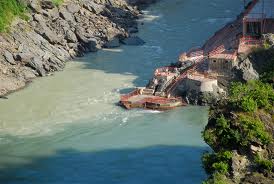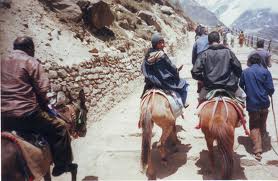Char Dham Yatra | Char Dham Yatra Uttaranchal India
About CharDham:
Char Dham is an important Hindu pilgrimage circuit in the Indian Himalayas. Located in the Garhwal region of the state of Uttarakhand(formerly the northwestern section of Uttar Pradesh), the circuit consists of four sites—Yamunotri , Gangotri , Kedarnath , and Badrinath. Badrinath is also one of the four destinations (with each destination being in different corners of the country) of the longer Char Dham from which the Chota Char Dham likely draws its name.
While each of these sites is unique in its own fashion, inclusion in the Char Dham has, over time, caused them be viewed together in popular imagination and in pilgrimage practice.
Pilgrimage centers:
Kedarnath Temple:
Kedarnath Mandir is one of the holiest Hindu temples dedicated to Lord Shiva and is located atop the Garhwal Himalayan range near the Mandakini river in Kedarnath, Uttarakhand in India. Due to extreme weather conditions, the temple is open only between the end of April to karmic purnima (full moon). During the winters, the murtis (idols) from Kedarnath temple are brought to Ukhimath and worshipped there for six months. In this region Lord Shiva is worshipped as Kedarnath, the 'Lord of Kedar Khand', the historical name of the region.
The temple is not directly accessible by road and has to be reached by a 14 km uphill trek from a hot waterbath. The temple is believed to have been built by Adi Sankaracharya and is one of the twelve Jyotirlingas, the holiest Hindu shrines of Shiva. The older temple existed from the times of Mahabharata, when the Pandavas are supposed to have pleased Shiva by doing penance in Kedarnath. The temple is also one of the four major sites in India's Chota Char Dham pilgrimage of Northern Himalayas.
Badrinath Temple:
Badrinath temple, sometimes called Badrinarayan temple, is situated along the Alaknanda river, in the hill town of Badrinath in Uttarakhand state in India. It is widely considered to be one of the holiest Hindu temples, and is dedicated to god Vishnu. The temple and town are one of the four Char Dham and Chota Char Dham pilgrimage sites. It is also one of the 108 Divya Desams, holy shrines for Vaishnavites. The temple is open only six months every year (between the end of April and the beginning of November), due to extreme weather conditions in the Himalayan region.
The temple is approximately 50 ft (15 metres) tall with a small cupola on top, covered with a gold gilt roof.The facade is built of stone, with arched windows. A broad stairway leads up to a tall arched gateway, which is the main entrance. The architecture resembles a Buddhist vihara (temple), with the brightly painted facade also more typical of Buddhism temples. Just inside is the mandapa, a large pillared hall that leads to the garbha grha, or main shrine area. The walls and pillars of the mandapa are covered with intricate carvings.
The Tapt Kund hot sulphur springs just below the temple are considered to be medicinal—many pilgrims consider it a requirement to bathe in the springs before visiting the temple. The springs have a year-round temperature of 45°C.
Gangotri|Gangotri Temple:
Gangotri is a town and a Nagar Panchayat (municipality) in Uttarkashi district in the state of Uttarakhand, India. It is a Hindu pilgrim town on the banks of the river Bhagirathi. It is on the Greater Himalayan Range, at a height of 3,415 m.
Gangotri, the origin of the River Ganges and seat of the goddess Ganga, is one of the four sites in the Char Dham pilgrimage circuit. The river is called Bhagirathi at the source and acquires the name Ganga (Ganges) from Devprayag onwards where it meets the Alaknanda. The origin of the holy river is at Gaumukh, set in the Gangotri Glacier, and is a 19 km trek from Gangotri. Gangotri can be reached in one day's travel from Rishikesh, Haridwar or Dehradun, or in two days from Yamunotri, the first site in the Char Dham circuit. More popular and important than its sister site to the east, Gangotri is also accessible directly by car and bus, meaning that it sees many more pilgrims than Yamunotri.
Ritual duties are supervised by the Semwal family of pujaris. The aarti ceremony at the Gangotri is especially impressive, as is the temple, a stately affair that sits on the banks of the rushing Ganges. Adventurous pilgrims can make an overnight 18 km trek to Gaumukh, the actual current source of the river Ganges.
For a large number of tourists, Gangotri town serves as the starting point of the Gangotri-Gaumukh-Tapovan and Gangotri-Kedartal trekking routes.
Yamunotri:
Yamunotri is the source of the Yamuna River and the seat of the Goddess Yamuna in Hinduism. It is situated at an altitude of 3,293 metres (10,804 ft) in the Garhwal Himalayas and located approximately 30 kilometers (19 mi) North of Uttarkashi, the headquarters of the Uttarkashi district in the Garhwal Division of Uttarakhand, India. It is one of the four sites in India's Chhota Char Dham pilgrimage. The sacred shrine of Yamunotri, source of the river Yamuna, is the westernmost shrine in the Garhwal Himalayas, perched atop a flank of Bandar Poonch Parvat. The chief attraction at Yamunotri is the temple devoted to the Goddess Yamuna and the holy thermal springs at Janki Chatti (7 km. Away).
The actual source, a frozen lake of ice and glacier (Champasar Glacier)located on the Kalind Mountain at a height of 4,421 m above sea level, about 1 km further up, is not frequented generally as it is not accessible; hence the shrine has been located on the foot of the hill. The approach is extremely difficult and pilgrims therefore offer puja at the temple itself.
Close to the temple are hot water springs gushing out from the mountain cavities. Surya Kund is the most important kund. Near the Surya Kund there is a shila called Divya Shila, which is worshipped before puja is offered to the deity. Devotees prepare rice and potatoes, tied in muslin cloth, to offer at the shrine by dipping them in these hot water springs. Rice so cooked is taken back home as prasadam. The pujaris of Yamunotri come from the village of Kharsali near Janki Chatti. They are the administrators of the sacred place and perform religious rites. They are well-versed in the Shastras.
Yamunotri temple:
Yamunotri temple is situated in the western region of Garhwal Himalayas at an altitude of 3,235 metres (10,614 ft) in Uttarkashi district, Uttarakhand. The temple is dedicated to Goddess Yamuna. The Yamunotri temple is a full day's journey from Uttarakhand's main towns — Rishikesh, Haridwar or Dehradun. The actual temple is only accessible by a 13 kilometres (8.1 mi) trek from the town of Hanuman Chatti and a 6 kilometres (3.7 mi) walk from Janki Chatti; horses or palanquins are available for rent. The hike from Hanuman Chatti to Yamunotri is very picturesque with beautiful views of a number of waterfalls. There are two trekking routes from Hanuman Chatti to Yamunotri, the one along the right bank proceeds via the Markandeya Tirth, where the sage Markandeya wrote the Markandeya Purana, the other route which lies on the left bank of the river goes via Kharsali, from where Yamunotri is a five or six hours climb away.
It is located at an altitude of 3,235 metres (10,614 ft) approximately. A little ahead is the actual source of the river Yamuna which is at an altitude of about 4,421 metres (14,505 ft) approximately. Two hot springs are also present at Yamunotri offering relief to tired hikers at a height of 3,292 metres (10,801 ft), Surya Kund, has boiling hot water, while Gauri Kund, had tepid water suitable for bathing The temple opens on Akshaya Tritiya(May) and closes on Yama Dwitiya (the second day after Diwali, November). Lodging at the temple itself is limited to a few small ashrams and guest-houses. Ritual duties such as the making and distribution of prasad (sanctified offerings) and the supervision of pujas(ritual venerations) are performed by the Uniyal family of pujaris (priests). Unique aspects of ritual practice at the site include hot springs where raw rice is cooked and made into prasad.
































